Analogue - and digital studio's-equipment and laboratories
- Roland Kuit
- Posts: 670
- Joined: Fri Dec 28, 2012 1:42 pm
- Location: NL/SWE
- Contact:
Re: Analogue studio's-equipment and laboratories
Siemens Studio
(1959-1969) as seen in the Deutsches Museum in Munich Germany
The studio equipments in this photograph are also referred as "Siemens synthesizer" in 120 Years of Electronic Music.
(also see: http://www.electricalaudio.com/phpBB3/v ... =5&t=28005)
Check out that wooden chamber reverb.
(1959-1969) as seen in the Deutsches Museum in Munich Germany
The studio equipments in this photograph are also referred as "Siemens synthesizer" in 120 Years of Electronic Music.
(also see: http://www.electricalaudio.com/phpBB3/v ... =5&t=28005)
Check out that wooden chamber reverb.
- Attachments
-
- keys.jpg (61.84 KiB) Viewed 5863 times
-
- DM_Recording_Studio.jpg (67.46 KiB) Viewed 5863 times
-
- chamber1.jpg (76.38 KiB) Viewed 5863 times
Avant-electronic composer | synthesis research | lecturer
http://www.rolandkuit.com/
http://www.rolandkuit.com/
Re: Analogue studio's-equipment and laboratories
thanks Roland!
this is good stuff to see!
this is good stuff to see!
- Roland Kuit
- Posts: 670
- Joined: Fri Dec 28, 2012 1:42 pm
- Location: NL/SWE
- Contact:
Re: Analogue studio's-equipment and laboratories
Studio d'Essai
Later the studio of:
Groupe de Recherche de Musique Concrète
In 1942 the French composer and theoretician Pierre Schaeffer, began his exploration of radiophony when he joined Jacques Copeau and his pupils in the foundation of the Studio d'Essai de la Radiodiffusion Nationale. The studio originally functioned as a center for the Resistance movement in French radio, which in August 1944 was responsible for the first broadcasts in liberated Paris. It was here that Schaeffer began to experiment with creative radiophonic techniques using the sound technologies of the time.
The development of Schaeffer’s practice was informed by encounters with voice actors and microphone usage and radiophonic art played an important part in inspiring and consolidating Schaeffer's conception of sound based composition. Another important influence on Schaeffer’s practice was cinema and the techniques of recording and montage, which were originally associated with cinematographic practice, came to "serve as the substrate of musique concrète." Marc Battier notes that, prior to Schaeffer, Jean Epstein drew attention to the manner in which sound recording revealed what was hidden in the act of basic acoustic listening. Epstein's reference to this "phenomenon of an epiphanic being", which appears through the transduction of sound, proved influential on Schaeffer’s concept of reduced listening. Schaeffer would explicitly cite Jean Epstein with reference to his use of extra-musical sound material. Epstein had already imagined that "through the transposition of natural sounds, it becomes possible to create chords and dissonances, melodies and symphonies of noise, which are a new and specifically cinematographic music".
By 1951 the work of Schaeffer, composer-percussionist Pierre Henry, and sound engineer Jacques Poullin had received official recognition and The Groupe de Recherches de Musique Concrète, Club d 'Essai de la Radiodiffusion-Télévision Française was established at RTF in Paris, the ancestor of the ORTF (Lange 2009, 173). At RTF the GRMC established the first purpose-built electroacoustic music studio. It quickly attracted many who either were or were later to become notable composers, including Olivier Messiaen, Pierre Boulez, Jean Barraqué, Karlheinz Stockhausen, Edgard Varèse, Iannis Xenakis, Michel Philippot, and Arthur Honegger. Compositional output from 1951 to 1953 comprised Étude I (1951) and Étude II (1951) by Boulez, Timbres-durées (1952) by Messiaen, Konkrete Etüde (1952) by Stockhausen, Le microphone bien tempéré (1952) and La voile d’Orphée (1953) by Henry, Étude I (1953) by Philippot, Étude (1953) by Barraqué, the mixed pieces Toute la lyre (1951) and Orphée 53 (1953) by Schaeffer/Henry, and the film music Masquerage (1952) by Schaeffer and Astrologie (1953) by Henry. In 1954 Varèse and Honegger visited to work on the tape parts of Déserts and La rivière endormie (Palombini 1999).
Between 1952 and 1956 Schaeffer's commitments to RTF led him to appoint Philippe Arthuys with responsibility for the GRMC, with Pierre Henry operating as Director of Works. Pierre Henry’s composing talent developed greatly during this period at the GRMC and he worked with experimental filmmakers such as Max de Haas, Jean Gremillon, Enrico Fulchignoni, and Jean Rouch, and with choreographers including Dick Sanders and Maurice Béjart (Gayou 2007, 206). Schaeffer returned to run the group at the end of 1957, and immediately stated his disapproval of the direction the GRMC had taken. A proposal was then made to "renew completely the spirit, the methods and the personnel of the Group, with a view to undertake research and to offer a much needed welcome to young composers"(Wiki).
Later the studio of:
Groupe de Recherche de Musique Concrète
In 1942 the French composer and theoretician Pierre Schaeffer, began his exploration of radiophony when he joined Jacques Copeau and his pupils in the foundation of the Studio d'Essai de la Radiodiffusion Nationale. The studio originally functioned as a center for the Resistance movement in French radio, which in August 1944 was responsible for the first broadcasts in liberated Paris. It was here that Schaeffer began to experiment with creative radiophonic techniques using the sound technologies of the time.
The development of Schaeffer’s practice was informed by encounters with voice actors and microphone usage and radiophonic art played an important part in inspiring and consolidating Schaeffer's conception of sound based composition. Another important influence on Schaeffer’s practice was cinema and the techniques of recording and montage, which were originally associated with cinematographic practice, came to "serve as the substrate of musique concrète." Marc Battier notes that, prior to Schaeffer, Jean Epstein drew attention to the manner in which sound recording revealed what was hidden in the act of basic acoustic listening. Epstein's reference to this "phenomenon of an epiphanic being", which appears through the transduction of sound, proved influential on Schaeffer’s concept of reduced listening. Schaeffer would explicitly cite Jean Epstein with reference to his use of extra-musical sound material. Epstein had already imagined that "through the transposition of natural sounds, it becomes possible to create chords and dissonances, melodies and symphonies of noise, which are a new and specifically cinematographic music".
By 1951 the work of Schaeffer, composer-percussionist Pierre Henry, and sound engineer Jacques Poullin had received official recognition and The Groupe de Recherches de Musique Concrète, Club d 'Essai de la Radiodiffusion-Télévision Française was established at RTF in Paris, the ancestor of the ORTF (Lange 2009, 173). At RTF the GRMC established the first purpose-built electroacoustic music studio. It quickly attracted many who either were or were later to become notable composers, including Olivier Messiaen, Pierre Boulez, Jean Barraqué, Karlheinz Stockhausen, Edgard Varèse, Iannis Xenakis, Michel Philippot, and Arthur Honegger. Compositional output from 1951 to 1953 comprised Étude I (1951) and Étude II (1951) by Boulez, Timbres-durées (1952) by Messiaen, Konkrete Etüde (1952) by Stockhausen, Le microphone bien tempéré (1952) and La voile d’Orphée (1953) by Henry, Étude I (1953) by Philippot, Étude (1953) by Barraqué, the mixed pieces Toute la lyre (1951) and Orphée 53 (1953) by Schaeffer/Henry, and the film music Masquerage (1952) by Schaeffer and Astrologie (1953) by Henry. In 1954 Varèse and Honegger visited to work on the tape parts of Déserts and La rivière endormie (Palombini 1999).
Between 1952 and 1956 Schaeffer's commitments to RTF led him to appoint Philippe Arthuys with responsibility for the GRMC, with Pierre Henry operating as Director of Works. Pierre Henry’s composing talent developed greatly during this period at the GRMC and he worked with experimental filmmakers such as Max de Haas, Jean Gremillon, Enrico Fulchignoni, and Jean Rouch, and with choreographers including Dick Sanders and Maurice Béjart (Gayou 2007, 206). Schaeffer returned to run the group at the end of 1957, and immediately stated his disapproval of the direction the GRMC had taken. A proposal was then made to "renew completely the spirit, the methods and the personnel of the Group, with a view to undertake research and to offer a much needed welcome to young composers"(Wiki).
- Attachments
-
- StudiodEssai-Schaeffe.jpg (16.61 KiB) Viewed 5820 times
-
- studidessay.jpg (15.39 KiB) Viewed 5820 times
Avant-electronic composer | synthesis research | lecturer
http://www.rolandkuit.com/
http://www.rolandkuit.com/
- Roland Kuit
- Posts: 670
- Joined: Fri Dec 28, 2012 1:42 pm
- Location: NL/SWE
- Contact:
Re: Analogue studio's-equipment and laboratories
IMEB (Institut International de Musique Electroacoustique de Bourges)
Founded in 1970 by Françoise Barrière and Christian Clozier, the Institut international de musique électroacoustique de Bourges (née Groupe de musique électroacoustique de Bourges) has played host to a diverse array of electronic composers, publishing their works largely via the Le Chant du Monde label's Chrysopée Electronique series, organizing concert events, and promoting the ongoing sound research that makes electronic music possible. For the most part, the many electronic music studio camps are difficult to truly characterize, with IMEB no exception. Given the many nations represented among its roster and their varied activities, the closest I can come to an IMEB worldview would be to welcome with open arms all practices electronic.
And a new build instruments for kids and MAX/MSP:
'Le Cybersongosse'
Founded in 1970 by Françoise Barrière and Christian Clozier, the Institut international de musique électroacoustique de Bourges (née Groupe de musique électroacoustique de Bourges) has played host to a diverse array of electronic composers, publishing their works largely via the Le Chant du Monde label's Chrysopée Electronique series, organizing concert events, and promoting the ongoing sound research that makes electronic music possible. For the most part, the many electronic music studio camps are difficult to truly characterize, with IMEB no exception. Given the many nations represented among its roster and their varied activities, the closest I can come to an IMEB worldview would be to welcome with open arms all practices electronic.
And a new build instruments for kids and MAX/MSP:
'Le Cybersongosse'
- Attachments
-
- Le Cybersongosse'.jpg (31.35 KiB) Viewed 5781 times
-
- bouges.jpg (180.54 KiB) Viewed 5781 times
Avant-electronic composer | synthesis research | lecturer
http://www.rolandkuit.com/
http://www.rolandkuit.com/
Re: Analogue studio's-equipment and laboratories
great topic, thanks roland!
Scope, Android, Web, PC Plugins and Sounds:
http://www.oceanswift.net
Music
https://faxinadu.bandcamp.com/
http://www.oceanswift.net
Music
https://faxinadu.bandcamp.com/
- Roland Kuit
- Posts: 670
- Joined: Fri Dec 28, 2012 1:42 pm
- Location: NL/SWE
- Contact:
Re: Analogue studio's-equipment and laboratories
Mark II refill
(The Columbia-Princeton Electronic Music Center (CMC))
from: http://www.jamesfei.com/pictures/pictur ... s-rca.html
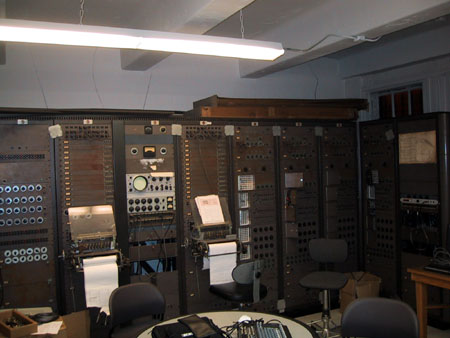
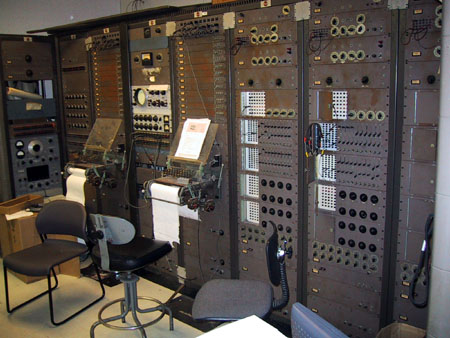
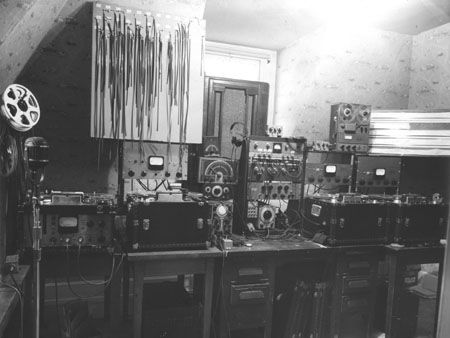
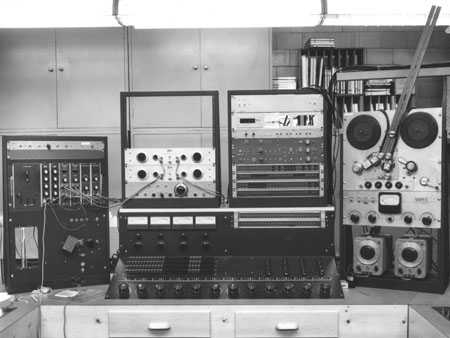
Fo more and detailed pictures, click link above.
(The Columbia-Princeton Electronic Music Center (CMC))
from: http://www.jamesfei.com/pictures/pictur ... s-rca.html




Fo more and detailed pictures, click link above.
Avant-electronic composer | synthesis research | lecturer
http://www.rolandkuit.com/
http://www.rolandkuit.com/
- Roland Kuit
- Posts: 670
- Joined: Fri Dec 28, 2012 1:42 pm
- Location: NL/SWE
- Contact:
Re: Analogue studio's-equipment and laboratories
ANS Synthesizer
The ANS Synthesizer is completed in Moscow by Yvgeny Murzin, using optical reading of sine waves on 5 glass discs to provide 1/6 semitone pitch resolution over 10 octaves.
In this case the sine waves generated by the ANS are printed onto five glass discs using a process that Murzin (an optical engineer) had to develop himself. Each disc has 144 individual tracks printed onto it, for a total of 720 microtones (discrete pitches), spanning 10 octaves. This yields a resolution of 1/72 octave (16.67 cents). The modulated light from these wheels is then projected onto the back of the synthesizer's interface. These are arranged in a continuous swath vertically, with low frequencies at the bottom and high frequencies at the top.
The user interface consists of a glass plate covered in non-drying opaque black mastic, which constitutes a drawing surface upon which the user makes marks by scratching through the mastic, and therefore allowing light to pass through at that point. In front of the glass plate sits a vertical bank of twenty photocells that send signals to twenty amplifiers and bandpass filters, each with its own gain adjust control. It is akin to a ten-octave equalizer with two knobs per octave. The ANS is fully polyphonic and will generate all 720 pitches simultaneously if required (a vertical scratch would accomplish this).
The glass plate can then be scanned left or right in front of the photocell bank in order to transcribe the drawing directly into pitches. In other words, it plays what one has drawn, similar to how a score is written. This process can be aided with a gear-motor drive (similar to an engineering lathe) or it can be moved manually. The scan speed is adjustable down to zero. The speed at which the score scans has no relation to pitch but serves only as a means of controlling duration.
Murzin named his invention in honour of the composer Alexander Nikolayevich Scriabin (ANS): Scriabin (1872–1915) was an occultist, theosophist, and early exponent of color-sound theories in composition. The synthesizer was housed in the electronic-music studio situated above the Scriabin Museum (just off of the Arbat in central Moscow) before moving to the basement of the central university on the corner of Bolshaya Nikitskaya. It was saved from the scrapheap thanks to Stanislav Kreichi, who persuaded the university to look after it.
The ANS was used by Stanislav Kreichi, Alfred Schnittke, Edison Denisov, Sofia Gubaidulina, and other Soviet composers. Edward Artemiev wrote many of his scores of the movies of Andrei Tarkovsky with the help of the ANS. Notably is Artemiev's score of Tarkovsky's Solaris in which the ANS was used to abstract, sci-fi effect akin to ambient music.
PC power supplies have replaced the old ones (February 2006)
After several years at the Theremin Center, the ANS (there is only one—the original was destroyed and this is the improved version) is now located in the Glinka State Central Museum of Musical Culture in Moscow.(Wiki)
http://youtu.be/ptRmDeoQQlw
The ANS Synthesizer is completed in Moscow by Yvgeny Murzin, using optical reading of sine waves on 5 glass discs to provide 1/6 semitone pitch resolution over 10 octaves.
In this case the sine waves generated by the ANS are printed onto five glass discs using a process that Murzin (an optical engineer) had to develop himself. Each disc has 144 individual tracks printed onto it, for a total of 720 microtones (discrete pitches), spanning 10 octaves. This yields a resolution of 1/72 octave (16.67 cents). The modulated light from these wheels is then projected onto the back of the synthesizer's interface. These are arranged in a continuous swath vertically, with low frequencies at the bottom and high frequencies at the top.
The user interface consists of a glass plate covered in non-drying opaque black mastic, which constitutes a drawing surface upon which the user makes marks by scratching through the mastic, and therefore allowing light to pass through at that point. In front of the glass plate sits a vertical bank of twenty photocells that send signals to twenty amplifiers and bandpass filters, each with its own gain adjust control. It is akin to a ten-octave equalizer with two knobs per octave. The ANS is fully polyphonic and will generate all 720 pitches simultaneously if required (a vertical scratch would accomplish this).
The glass plate can then be scanned left or right in front of the photocell bank in order to transcribe the drawing directly into pitches. In other words, it plays what one has drawn, similar to how a score is written. This process can be aided with a gear-motor drive (similar to an engineering lathe) or it can be moved manually. The scan speed is adjustable down to zero. The speed at which the score scans has no relation to pitch but serves only as a means of controlling duration.
Murzin named his invention in honour of the composer Alexander Nikolayevich Scriabin (ANS): Scriabin (1872–1915) was an occultist, theosophist, and early exponent of color-sound theories in composition. The synthesizer was housed in the electronic-music studio situated above the Scriabin Museum (just off of the Arbat in central Moscow) before moving to the basement of the central university on the corner of Bolshaya Nikitskaya. It was saved from the scrapheap thanks to Stanislav Kreichi, who persuaded the university to look after it.
The ANS was used by Stanislav Kreichi, Alfred Schnittke, Edison Denisov, Sofia Gubaidulina, and other Soviet composers. Edward Artemiev wrote many of his scores of the movies of Andrei Tarkovsky with the help of the ANS. Notably is Artemiev's score of Tarkovsky's Solaris in which the ANS was used to abstract, sci-fi effect akin to ambient music.
PC power supplies have replaced the old ones (February 2006)
After several years at the Theremin Center, the ANS (there is only one—the original was destroyed and this is the improved version) is now located in the Glinka State Central Museum of Musical Culture in Moscow.(Wiki)
http://youtu.be/ptRmDeoQQlw
- Attachments
-
- ANS Synthesizer.jpg (67.16 KiB) Viewed 5727 times
Avant-electronic composer | synthesis research | lecturer
http://www.rolandkuit.com/
http://www.rolandkuit.com/
- Roland Kuit
- Posts: 670
- Joined: Fri Dec 28, 2012 1:42 pm
- Location: NL/SWE
- Contact:
Re: Analogue studio's-equipment and laboratories
Siemens update
Wow, I found 7 Siemens video's here:
http://www.youtube.com/playlist?list=PL84027969B66FECBD
Have fun!
Wow, I found 7 Siemens video's here:
http://www.youtube.com/playlist?list=PL84027969B66FECBD
Have fun!
Avant-electronic composer | synthesis research | lecturer
http://www.rolandkuit.com/
http://www.rolandkuit.com/
- Roland Kuit
- Posts: 670
- Joined: Fri Dec 28, 2012 1:42 pm
- Location: NL/SWE
- Contact:
Re: Analogue studio's-equipment and laboratories
Elektronmusikstudion Sverige
Elektronmusikstudion (EMS), formerly known as Electroacoustic Music in Sweden, is the Swedish national centre for electronic music and sound art. The research organisation started in 1964 and is based in Stockholm.
EMS was raised in 1964 by the Swedish composer Karl Birger Blomdahl, when he started working for the Swedish Radio. In addition to this job he requested for a special studio to allow him to produce electronic music. The Norwegian composer Knut Wiggen became the director of this studio called klangverstan (sound workshop) at first. EMS became independent of the radio in 1969.
Nowadays EMS organises courses, events, artist in residence activities. The organisation owns six studios and also owns a library archive with a large collection of books about electronic music, sound art and related topics.(Wiki)
For video's:
http://www.elektronmusikstudion.se/about/history
Elektronmusikstudion (EMS), formerly known as Electroacoustic Music in Sweden, is the Swedish national centre for electronic music and sound art. The research organisation started in 1964 and is based in Stockholm.
EMS was raised in 1964 by the Swedish composer Karl Birger Blomdahl, when he started working for the Swedish Radio. In addition to this job he requested for a special studio to allow him to produce electronic music. The Norwegian composer Knut Wiggen became the director of this studio called klangverstan (sound workshop) at first. EMS became independent of the radio in 1969.
Nowadays EMS organises courses, events, artist in residence activities. The organisation owns six studios and also owns a library archive with a large collection of books about electronic music, sound art and related topics.(Wiki)
For video's:
http://www.elektronmusikstudion.se/about/history
- Attachments
-
- Computerized_synthezisers_Knut_Wiggen_1967_Elektronmusikstudion_EMS_Stockholm_IMG_0259.jpg (82.48 KiB) Viewed 5708 times
-
- ems stockholm.jpg (161.4 KiB) Viewed 5708 times
Avant-electronic composer | synthesis research | lecturer
http://www.rolandkuit.com/
http://www.rolandkuit.com/
- Roland Kuit
- Posts: 670
- Joined: Fri Dec 28, 2012 1:42 pm
- Location: NL/SWE
- Contact:
Re: Analogue studio's-equipment and laboratories
The ‘Beauchamp Synthesiser’ or ‘Harmonic Tone Generator’
James Beauchamp, USA, 1964
James Beauchamp invented the Harmonic Tone Generator in 1964, one of the first additive electronic voltage-controlled synthesisers, under the direction of Lejaren Hiller at the Experimental Music Studio at the University of Illinois at Urbana-Champaign.
“The instrument synthesised six exact harmonics with variable fundamental frequency from 0 to 2000 Hz. The amplitudes of the six harmonics, the fundamental frequency, and the phase of the second harmonic were programmed by voltage control. The fundamental frequency (pitch) was controlled by an external keyboard or generators to provide vibrato and other effects. Control of amplitude was provided by special envelope generators or external generators or even by microphone or prerecorded sounds.
The harmonics were derived by generating pairs of ultrasonic frequencies which were nonlinearly mixed to produce audio difference frequencies. That is to say, one set of frequencies, 50 KHz, 100 KHz, …, 300 KHz, was fixed. Another set, 50-52 KHz, 100-104 KHz, …, 300-312 KHz, was variable. When 50 and 50-52 KHz, etc., was mixed, the sine tones 0-2 KHz, … was derived. Harmonics were generated by full-wave rectification (even harmonics) and square wave chopping (odd harmonics), followed by band pass filtering to separate the harmonics.
The envelope generators consisted of variable delays and attack/decay circuits. In response to a trigger signal from the keyboard, after a programmed delay, the envelope generator would either rise and then go into an immediate decay while the key is depressed or it would rise and decay after the key is depressed. Having the upper harmonics delayed with respect to the lower ones gave an interesting effect.
Because the amplitude controls were “bipolar” (i.e., either positive or negative controls were effective), the instrument could serve as a multi-frequency “ring modulator”, which was especially useful when the controls were derived from a voice or musical instrument. The frequency control was also bipolar and was capable of producing rich sound spectra when the control was taken from a sine generator operating at frequencies ranging from 20 Hz through several hundred Hz. This FM effect was very popular for producing sounds useful in electronic music compositions.”
James Beauchamp.
http://ems.music.uiuc.edu/beaucham/htg.html
James Beauchamp, USA, 1964
James Beauchamp invented the Harmonic Tone Generator in 1964, one of the first additive electronic voltage-controlled synthesisers, under the direction of Lejaren Hiller at the Experimental Music Studio at the University of Illinois at Urbana-Champaign.
“The instrument synthesised six exact harmonics with variable fundamental frequency from 0 to 2000 Hz. The amplitudes of the six harmonics, the fundamental frequency, and the phase of the second harmonic were programmed by voltage control. The fundamental frequency (pitch) was controlled by an external keyboard or generators to provide vibrato and other effects. Control of amplitude was provided by special envelope generators or external generators or even by microphone or prerecorded sounds.
The harmonics were derived by generating pairs of ultrasonic frequencies which were nonlinearly mixed to produce audio difference frequencies. That is to say, one set of frequencies, 50 KHz, 100 KHz, …, 300 KHz, was fixed. Another set, 50-52 KHz, 100-104 KHz, …, 300-312 KHz, was variable. When 50 and 50-52 KHz, etc., was mixed, the sine tones 0-2 KHz, … was derived. Harmonics were generated by full-wave rectification (even harmonics) and square wave chopping (odd harmonics), followed by band pass filtering to separate the harmonics.
The envelope generators consisted of variable delays and attack/decay circuits. In response to a trigger signal from the keyboard, after a programmed delay, the envelope generator would either rise and then go into an immediate decay while the key is depressed or it would rise and decay after the key is depressed. Having the upper harmonics delayed with respect to the lower ones gave an interesting effect.
Because the amplitude controls were “bipolar” (i.e., either positive or negative controls were effective), the instrument could serve as a multi-frequency “ring modulator”, which was especially useful when the controls were derived from a voice or musical instrument. The frequency control was also bipolar and was capable of producing rich sound spectra when the control was taken from a sine generator operating at frequencies ranging from 20 Hz through several hundred Hz. This FM effect was very popular for producing sounds useful in electronic music compositions.”
James Beauchamp.
http://ems.music.uiuc.edu/beaucham/htg.html
- Attachments
-
- Beauchamp synthesizer.png (234.12 KiB) Viewed 5596 times
Avant-electronic composer | synthesis research | lecturer
http://www.rolandkuit.com/
http://www.rolandkuit.com/
Re: Analogue studio's-equipment and laboratories
Dear Roland, Im soooo happy to live in 2014, having pulsar and some Outboard, but these Pictures are to much cupboads, they would drive me crazy. Im happy to live today, but these pics are awesome 
These people arent musican, they are only operators for there machines, what a pitty. Even today there are a lot of musicans, they are operators or mousemovers, never hat a keyboard with 88 or 61 keys in there hands.
These people arent musican, they are only operators for there machines, what a pitty. Even today there are a lot of musicans, they are operators or mousemovers, never hat a keyboard with 88 or 61 keys in there hands.
Re: Analogue studio's-equipment and laboratories
don't underestimate other people. There are a lot of people being technicians and musicians at the same time. Nor to say that they could have, even more abilities. It's better to try to observe the world in a more spherical view, it's not flat. Every thing is colective work, through progress and history. Computer useage is not valueless at all. It is this that holds our world together.
As for a 88 keys keyboard, even my grandmother has one!
As for a 88 keys keyboard, even my grandmother has one!
Last edited by fra77x on Thu Feb 06, 2014 6:44 am, edited 1 time in total.
Re: Analogue studio's-equipment and laboratories
Lovin' this 
There's a contemporary album of music written for the ANS by Coil: http://www.discogs.com/Coil-ANS/release/334657
Awesome stuff!
There's a contemporary album of music written for the ANS by Coil: http://www.discogs.com/Coil-ANS/release/334657
Awesome stuff!
-
hubird
Re: Analogue studio's-equipment and laboratories
ever heard of Kraftwerk? Die sprechen und schreiben zufällig auch Deutsch...anabella wrote:Dear Roland, Im soooo happy to live in 2014, having pulsar and some Outboard, but these Pictures are to much cupboads, they would drive me crazy. Im happy to live today, but these pics are awesome
These people arent musican, they are only operators for there machines, what a pitty. Even today there are a lot of musicans, they are operators or mousemovers, never hat a keyboard with 88 or 61 keys in there hands.
- Roland Kuit
- Posts: 670
- Joined: Fri Dec 28, 2012 1:42 pm
- Location: NL/SWE
- Contact:
Re: Analogue studio's-equipment and laboratories
CSIR Mk1 & CSIRAC,
Trevor Pearcey & Geoff Hill, Australia, 1951
CSIRAC was an early digital computer designed by the British engineer Trevor Pearcey as part of a research project at CSIRO ( Sydney-based Radiophysics Laboratory of the Council for Scientific and Industrial Research) in the early 1950′s. CSIRAC was intended as a prototype for a much larger machine use and therefore included a number of innovative ‘experimental’ features such as video and audio feedback designed to allow the operator to test and monitor the machine while it was running. As well as several optical screens, CSIR Mk1 had a built-in Rola 5C speaker mounted on the console frame. The speaker was an output device used to alert the programmer that a particular event had been reached in the program; commonly used for warnings, often to signify the end of the program and sometimes as a debugging aid. The output to the speaker was basic raw data from the computer’s bus and consisted of an audible click. To create a more musical tone, multiple clicks were combined using a short loop of instructions; the timing of the loop giving a change in frequency and therefore an audible change in pitch.
The CSIR Mk1 was dismantled in 1955 and moved to The University of Melbourne, where it was renamed CSIRAC. Professor of Mathematics, Thomas Cherry, had a great interest in programming and music and he created music with CSIRAC. During it’s time in Melbourne the practice of music programming on the CSIRAC was refined allowing the input of music notation. The program tapes for a couple of test scales still exist, along with the popular melodies ‘So early in the Morning’ and ‘In Cellar Cool’.
Trevor Pearcey & Geoff Hill, Australia, 1951
CSIRAC was an early digital computer designed by the British engineer Trevor Pearcey as part of a research project at CSIRO ( Sydney-based Radiophysics Laboratory of the Council for Scientific and Industrial Research) in the early 1950′s. CSIRAC was intended as a prototype for a much larger machine use and therefore included a number of innovative ‘experimental’ features such as video and audio feedback designed to allow the operator to test and monitor the machine while it was running. As well as several optical screens, CSIR Mk1 had a built-in Rola 5C speaker mounted on the console frame. The speaker was an output device used to alert the programmer that a particular event had been reached in the program; commonly used for warnings, often to signify the end of the program and sometimes as a debugging aid. The output to the speaker was basic raw data from the computer’s bus and consisted of an audible click. To create a more musical tone, multiple clicks were combined using a short loop of instructions; the timing of the loop giving a change in frequency and therefore an audible change in pitch.
The CSIR Mk1 was dismantled in 1955 and moved to The University of Melbourne, where it was renamed CSIRAC. Professor of Mathematics, Thomas Cherry, had a great interest in programming and music and he created music with CSIRAC. During it’s time in Melbourne the practice of music programming on the CSIRAC was refined allowing the input of music notation. The program tapes for a couple of test scales still exist, along with the popular melodies ‘So early in the Morning’ and ‘In Cellar Cool’.
- Attachments
-
- CSIRAC_Trevor_Pearcey_CSIR_Mk1_Maston_Beard_Geoff_Hill_Australia_Computer_Music.jpg (110.57 KiB) Viewed 5528 times
Avant-electronic composer | synthesis research | lecturer
http://www.rolandkuit.com/
http://www.rolandkuit.com/
- Roland Kuit
- Posts: 670
- Joined: Fri Dec 28, 2012 1:42 pm
- Location: NL/SWE
- Contact:
Re: Analogue studio's-equipment and laboratories
Dear forum,
I have mentioned the studio EMS Stockholm in a former post as the most important electronic studio in Scandinavia.
This time I am honoured to announce that I will be Composer in the Residence of EMS Stockholm.
I will do research with the Buchla 200 in combination with my Kyma / Pacarana sysem.
Here an old picture of the studio:
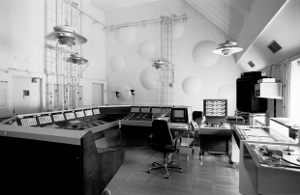
And here their Flagship I will work with, the Buchla 200:
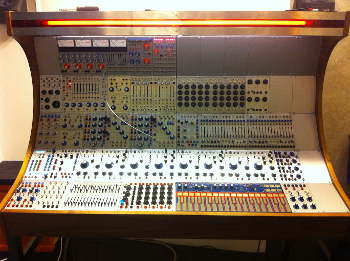
EMS Stockholm link:
http://www.elektronmusikstudion.se/news ... oland-kuit
I have mentioned the studio EMS Stockholm in a former post as the most important electronic studio in Scandinavia.
This time I am honoured to announce that I will be Composer in the Residence of EMS Stockholm.
I will do research with the Buchla 200 in combination with my Kyma / Pacarana sysem.
Here an old picture of the studio:

And here their Flagship I will work with, the Buchla 200:

EMS Stockholm link:
http://www.elektronmusikstudion.se/news ... oland-kuit
Avant-electronic composer | synthesis research | lecturer
http://www.rolandkuit.com/
http://www.rolandkuit.com/
- Roland Kuit
- Posts: 670
- Joined: Fri Dec 28, 2012 1:42 pm
- Location: NL/SWE
- Contact:
Re: Analogue studio's-equipment and laboratories
The CLAEM Electronic Music Laboratory, Buenos Aires
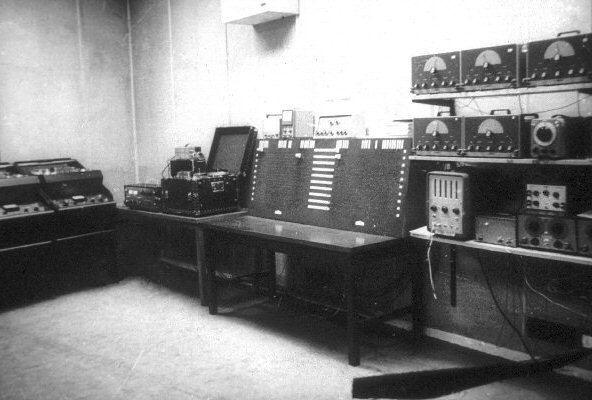
Founded by classical composer Alberto Ginastera, CLAEM (the Latin American Center for Advanced Musical Studies) was made part of the institute in 1962, yielding numerous productions of dodecaphonic, electronic, and acoustic music; CLAEM attracted prominent international guest lecturers such as Aaron Copland, Luigi Nono, and Iannis Xenakis. A visual arts center (CAV) was also inaugurated at the new address. Directed by Romero Brest, CAV became the leading Buenos Aires center for the display and promotion for avant-garde creations. CAV introduced art patrons to sculptors Juan Carlos Distéfano, Julio Le Parc, and Clorindo Testa, as well as painters Romulo Macció, Luis Felipe Noé, Jorge de la Vega, Ernesto Deira, Antonio Seguí, and conceptual artists such as Edgardo Giménez and Marta Minujín. (Wiki)
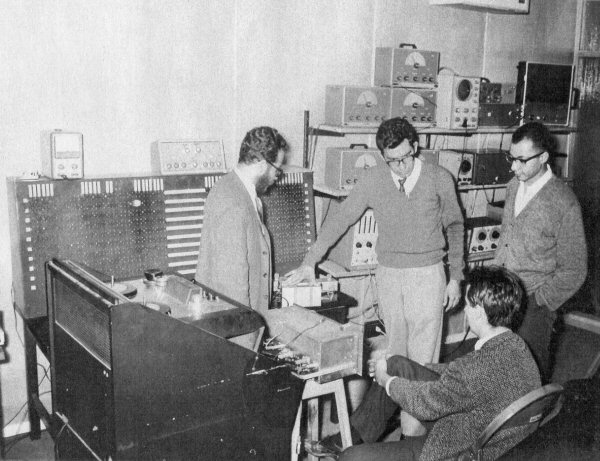



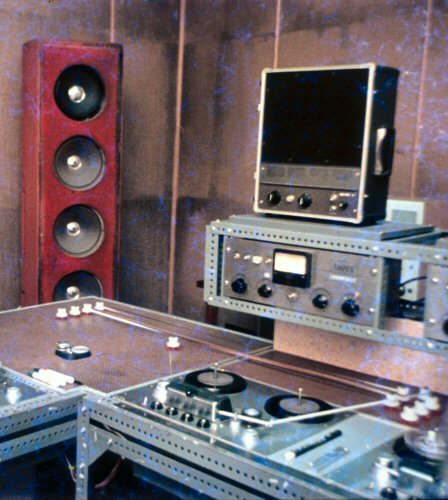

Founded by classical composer Alberto Ginastera, CLAEM (the Latin American Center for Advanced Musical Studies) was made part of the institute in 1962, yielding numerous productions of dodecaphonic, electronic, and acoustic music; CLAEM attracted prominent international guest lecturers such as Aaron Copland, Luigi Nono, and Iannis Xenakis. A visual arts center (CAV) was also inaugurated at the new address. Directed by Romero Brest, CAV became the leading Buenos Aires center for the display and promotion for avant-garde creations. CAV introduced art patrons to sculptors Juan Carlos Distéfano, Julio Le Parc, and Clorindo Testa, as well as painters Romulo Macció, Luis Felipe Noé, Jorge de la Vega, Ernesto Deira, Antonio Seguí, and conceptual artists such as Edgardo Giménez and Marta Minujín. (Wiki)




Avant-electronic composer | synthesis research | lecturer
http://www.rolandkuit.com/
http://www.rolandkuit.com/
- Roland Kuit
- Posts: 670
- Joined: Fri Dec 28, 2012 1:42 pm
- Location: NL/SWE
- Contact:
Re: Analogue studio's-equipment and laboratories
UPIC (Unité Polyagogique Informatique CEMAMu) is a computerised musical composition tool, devised by the composer Iannis Xenakis. It was developed at the Centre d'Etudes de Mathématique et Automatique Musicales (CEMAMu) in Paris, and was completed in 1977. Xenakis used it on his subsequent piece Mycènes Alpha (197, and it has been used by composers such as Jean-Claude Risset (on Saxatile (1992)), Takehito Shimazu (Illusions in Desolate Fields (1994)), Mari King, and Curtis Roads. Aphex Twin talked about it in an interview
Physically, the UPIC is a digitising tablet linked to a computer, which has a vector display. Its functionality is similar to that of the later Fairlight CMI, in that the user draws waveforms and volume envelopes on the tablet, which are rendered by the computer. Once the waveforms have been stored, the user can compose with them by drawing "compositions" on the tablet, with the X-axis representing time, and the Y-axis representing pitch. The compositions can be stretched in duration from a few seconds to an hour. They can also be transposed, reversed, inverted, and subject to a number of algorithmic transformations. The system allows for real time performance by moving the stylus across the tablet. The UPIC system has subsequently been expanded to allow for digitally sampled waveforms as source material, rather than purely synthesised tones. In 2005, Mode Records of New York released a 2-CD compilation of works composed with the UPIC, entitled Xenakis, UPIC, Continuum, which provides an overview of the machine's sonic possibilities.
There were a couple of attempts to reproduce the UPIC system using commodity hardware, for instance Iannix and HighC. IanniX, which has been sponsored by the French Ministry of Culture, is a graphical open-source sequencer which syncs via OpenSound Contro Open_Sound_Control Open_Sound_Control
events and curves to a real-time environment (like Pure Data, SuperCollider, Kyma, Csound, MaxMSP, openFrameworks, vvvv…). For its part, HighC is currently used as a pedagogical tool in classes ranging from early teens to Master classes in composition, while some contemporary composers, such as George Hatzimichelakis have made it part of their toolset.(wiki)
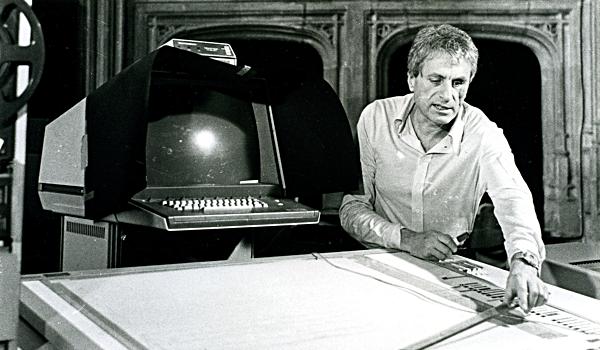
Iannis Xenakis probably while illustrating the operation of the UPIC system, in particular focusing on graphic tablet on which it is bent. The late seventies.
"… was the inadequacy of traditional musical graphics to push me in this direction, but in this case I was very passionate even about teaching destination". (I. Xenakis, 1988)
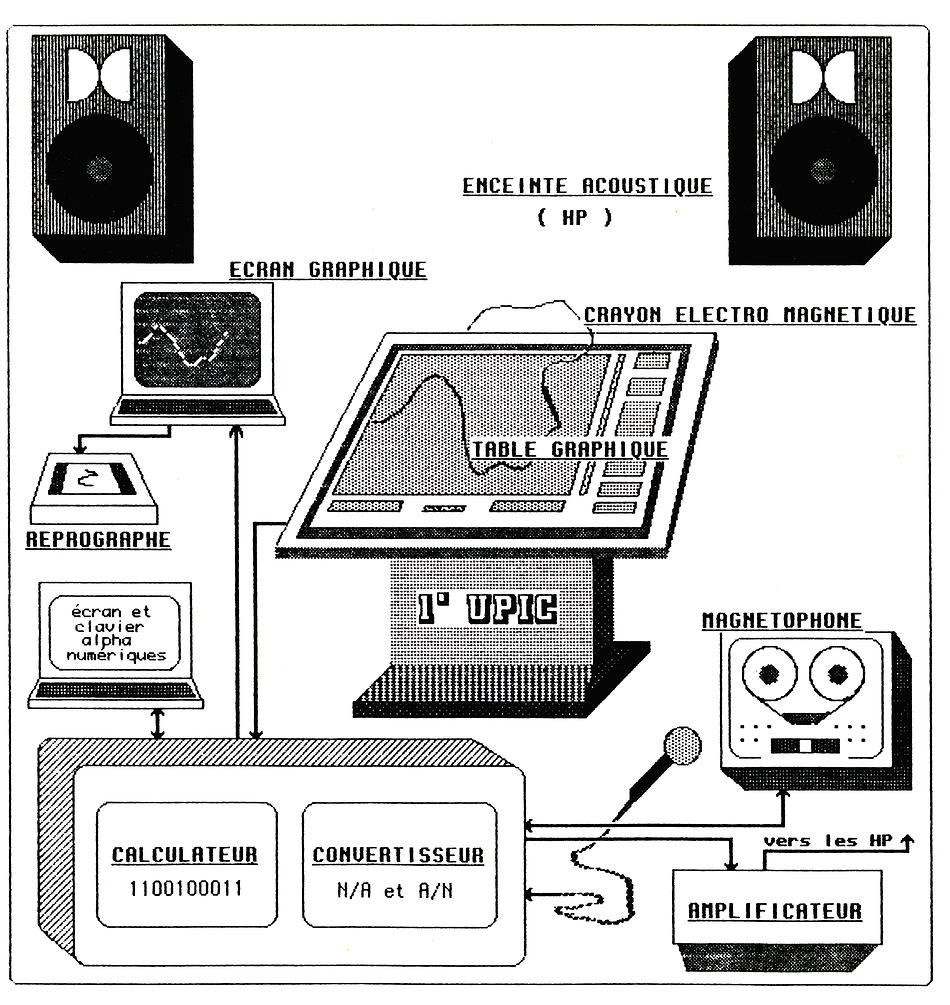

Physically, the UPIC is a digitising tablet linked to a computer, which has a vector display. Its functionality is similar to that of the later Fairlight CMI, in that the user draws waveforms and volume envelopes on the tablet, which are rendered by the computer. Once the waveforms have been stored, the user can compose with them by drawing "compositions" on the tablet, with the X-axis representing time, and the Y-axis representing pitch. The compositions can be stretched in duration from a few seconds to an hour. They can also be transposed, reversed, inverted, and subject to a number of algorithmic transformations. The system allows for real time performance by moving the stylus across the tablet. The UPIC system has subsequently been expanded to allow for digitally sampled waveforms as source material, rather than purely synthesised tones. In 2005, Mode Records of New York released a 2-CD compilation of works composed with the UPIC, entitled Xenakis, UPIC, Continuum, which provides an overview of the machine's sonic possibilities.
There were a couple of attempts to reproduce the UPIC system using commodity hardware, for instance Iannix and HighC. IanniX, which has been sponsored by the French Ministry of Culture, is a graphical open-source sequencer which syncs via OpenSound Contro Open_Sound_Control Open_Sound_Control
events and curves to a real-time environment (like Pure Data, SuperCollider, Kyma, Csound, MaxMSP, openFrameworks, vvvv…). For its part, HighC is currently used as a pedagogical tool in classes ranging from early teens to Master classes in composition, while some contemporary composers, such as George Hatzimichelakis have made it part of their toolset.(wiki)

Iannis Xenakis probably while illustrating the operation of the UPIC system, in particular focusing on graphic tablet on which it is bent. The late seventies.
"… was the inadequacy of traditional musical graphics to push me in this direction, but in this case I was very passionate even about teaching destination". (I. Xenakis, 1988)


Avant-electronic composer | synthesis research | lecturer
http://www.rolandkuit.com/
http://www.rolandkuit.com/
Re: Analogue studio's-equipment and laboratories
Great thread.
Thanks Roland.
-Tom
Thanks Roland.
-Tom